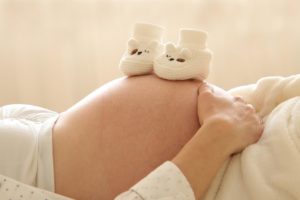According to a study summarized in Gastroenterology Consultant, pregnant women with intrahepatic cholestasis of pregnancy are much more likely to also be diagnosed with nonalcoholic fatty liver disease. You can find the full study published in Gastroenterology.
About Intrahepatic Cholestasis
Intrahepatic cholestasis of pregnancy (ICP) is a disorder that occurs in pregnant women that causes bile to build up in the liver. Bile is a digestive fluid that helps your liver break down fat. With ICP, bile salts in the bloodstream cause the main symptom: severe itchiness, especially on the hands and feet.
Symptoms of ICP most commonly appear during the third trimester and disappear after the baby is born. The itching may get worse at night or closer to the baby’s due date. Additional symptoms include nausea, jaundice, and loss of appetite. While there is no cure for ICP, patients can speak to their doctors about itch management treatments. Learn more about intrahepatic cholestasis here.
About Nonalcoholic Fatty Liver Disease
Nonalcoholic fatty liver disease (NAFLD) is a disease that occurs where fat builds up in the liver. Symptoms may include fatigue and abdominal pain. If NAFLD is not treated, it can develop into nonalcoholic steatohepatitis (NASH), which is marked by a fat buildup alongside damage and inflammation. NASH can cause scar tissue in the liver, causing lowered function.
NAFLD is most likely to develop in patients who are overweight, have high cholesterol, and have diabetes. Symptoms, as it progresses, include swollen lower extremities, mental confusion, nausea, weight loss, and fatigue. Learn more about NAFLD/NASH on our website.
The Study
Dr. Tatyana Kushner, one of the authors of the study, explained that NAFLD is becoming more common worldwide but especially in the United States. She states that it is actually the main cause for women needing liver transplants. Originally, the study hypothesized that there was a connection between the growth and prevalence of intrahepatic cholestasis and NAFLD because both can present with increased bile acids.
Additionally, ICP is known to intersect with liver conditions like Hepatitis C. As such, researchers were curious whether they could find any new connections between ICP and NAFLD.
Learning about Intrapehatic Cholestasis
One question that the research team frequently received was how a specific diagnosis of intrahepatic cholestasis was given to patients. One issue is that pregnant patients may not mention symptoms until later in the gestational process. Researchers had to examine study participants multiple times to ensure that ICP was present. Generally, this was affirmed through the presence of elevated bile acids. Additionally, researchers took into account whether doctors believed that certain patients had ICP.
Dr. Erica Monrose, another study author, also shared that one driving question for the study was whether patients likely to get ICP and NAFLD had some sort of underlying metabolic risk. For example, the Hispanic population is genetically predisposed to fatty liver disease. In the groups being studied, there seemed to be an equal Hispanic presence. All study participants also shared similar body mass indexes, or the analysis of body fat in relation to height and weight.
Findings
Ultimately, individuals with intrahepatic cholestasis were still found to be more at risk (5.7x more likely) to receive a NAFLD diagnosis than individuals without ICP. This is important as fatty liver disease can lead to preeclampsia or other pregnancy complications. Additionally, babies can be born prematurely.
Because of this, patients with ICP who are at risk of developing or have developed NAFLD should take extra pregnancy precautions to ensure safe delivery.
Montrose notes that clinicians should start testing more pregnant patients for liver disease, especially if they display elevated liver test results. She notes that:
“Patients with ICP rarely see a liver specialist. Also, there are no guidelines for follow-up…after pregnancy.”
Instead of being reactive, Montrose and her team encourage both doctors and patients to be proactive in their approach. During an ultrasound, look for signs of steatosis (fat buildup). This means that ICP or NAFLD may occur, even if asymptomatic in that moment. This proactivity also includes more liver tests and empowering women to report symptoms.







